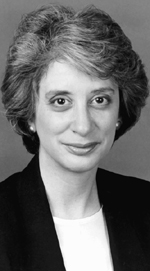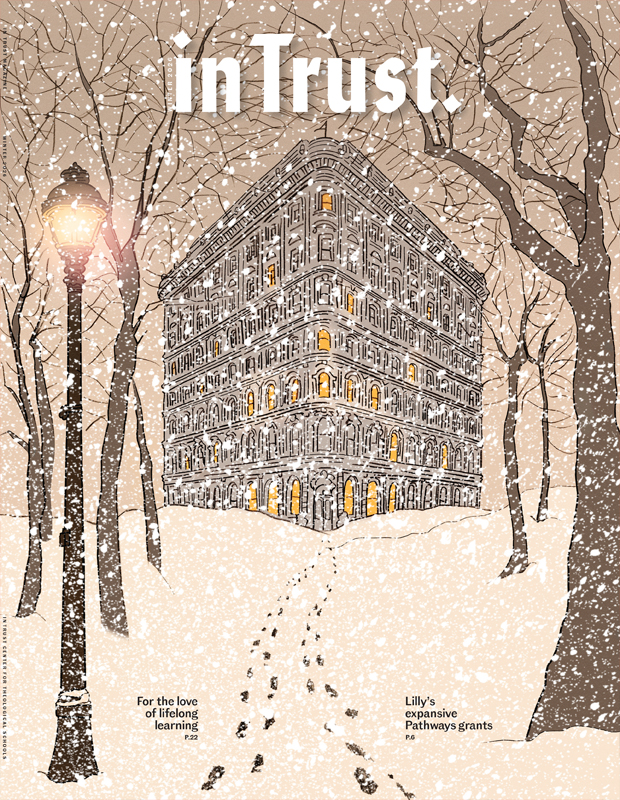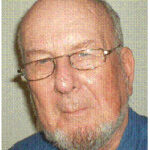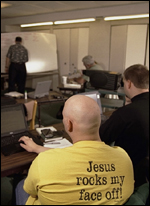 |
| Barbara G. Wheeler
Illustrations by |
Question for the governing board: Who are the next five people who will be named or recommended to fill vacancies on your board?
That’s a question a disturbingly large number of boards of North American theological schools are unprepared to answer, suggests the first thoroughgoing survey ever of the trustees of 193 of these schools. The survey, conducted by Auburn Theological Seminary, queried 4,274 members of theological school governing boards in the United States and Canada. The mailing list the surveyors used was provided by In Trust with the permission of the chief executives of the schools surveyed.
Analysis of the 1,611 responses (38 percent) shows that the membership of these boards is very old—52 percent of these trustees are 60 or older, compared to 36 percent of the membership of private college boards, 30 percent of public college boards, and 19 percent of the general run of nonprofit boards; 18 percent of seminary board members—nearly one in five—are 70 or older. The age of theological school board members alone indicates that a large number of board seats will need new occupants in the near future.
But other findings of the survey, its analysts say, suggest that the pool of potential new board members is shrinking, and board members report that the subject of replacing themselves commands relatively little of their attention.
Other areas of board weakness also emerged in the findings, most notably in members’ financial support of the institutions they serve and in their assessment of their performance as public advocates of theological education and of their own schools in particular. Such advocacy is a major way in which board members can add value to their schools.
| Occupations of Trustees
Percent of Trustees Holding a Degree Age of Trustees by Decade Gender of Trustees Trustees Who Switched Denominations Source: Auburn Theological Seminary survey of 193 governing boards of North American seminaries, 2001. |
| To view charts, click here. |
A Reluctance in Giving
The survey data, reported in a monograph titled In Whose Hands: A Study of Theological School Trustees, by Barbara G. Wheeler, represent the most recent findings of more than a decade’s research conducted by Auburn’s Center for the Study of Theological Education. The study of trustees was directed by Wheeler, who is president of Auburn Seminary, and Suzanne Nakasian. It was funded by the Booth-Ferris Foundation.
“Data on giving are especially worrisome,” Wheeler said in her report. In the last five years, theological schools as a whole derived 32 percent of their income from gifts, half of which came from graduates or other individuals. While most nonprofit institutions depend on board members to be major sources of operating and capital gifts, however, in none of the five years did theological school trustees provide more than about 10 percent of gifts received.
“Giving by trustees, whatever the actual amounts, is a sign of their commitment to and zeal for the institution,” Wheeler writes. “Those who make it a priority to give money often give the school quality attention as well. Fewer than one in five theological trustees (18 percent) say that the theological school they serve as trustee is their highest priority in giving, and even more surprising, in light of the average age of theological school trustees, only 32 percent have made provision for the school in their will. (Lay trustees are no more likely to have made a deferred arrangement than clergy.) Indeed, most theological schools have some board members who do not contribute at all. Despite the fact that full board participation in giving is universally acknowledged to be a cornerstone of a successful fund-raising program, most theological schools fail the test: only 15 percent report that all board members made a contribution in the year 2000.”
In arraying the data, the survey analysts broke down free-standing theological schools into six types: mainline denominational schools, mainline independent schools, evangelical denominational schools, evangelical independent schools, Roman Catholic schools, and schools from the anabaptist, or “peace church,” tradition, such as Mennonites, Brethren, and Quakers. (University-related divinity schools, which do not have their own governing boards, were not included in the survey.) In the charts accompanying this article, the six types are labeled M/D, M/I, E/D, E/I, Catholic and Peace respectively.
| The Variousness of Boards Theological school boards in some instances differ quite sharply from one another depending on the Christian tradition from which they rise and the constituency their school serves. These charts, based on data gathered in the Auburn trustee survey, display some of the similarities and contrasts. Key: M/I = E/D = E /I = Catholic = Peace = |
| To view charts, click here. |
When trustees’ giving patterns were sorted by school type, some significant differences emerged, as the charts on pages 16 and 17 show. The median gift of trustees of Catholic schools in 2001 hovered around $300, somewhat less than one-third of the roughly $1,000 median gift of trustees of four types of non-Catholic schools. By contrast, trustees of evangelical independent schools—whose boards are noted for their strength, loyalty, and longevity of service—had a median gift of just under $2,000.
The comparison shifts when ninetieth percentile gifts for 2001 are examined (a ninetieth percentile gift is the smallest gift made by a trustee among the 10 percent who are the most generous givers). Ninetieth percentile trustee donors from denominational schools, both mainline and evangelical, and from Catholic schools all gave around $10,000. Evangelical independent trustees again topped the scale, with a gift of $25,500, while the mainline independent ninetieth percentile gift was $15,700. The peace church gift, coming perhaps from boards with fewer affluent members (peace church boards also have the highest proportion of ordained members), was $6,000.
Some Missing Talents
The overwhelming preponderance of trustees like the experience of board service: 54 percent rated the experience as excellent, another 40 percent as good. Most thought they had delegated sufficient authority to the chief executive and had developed a trusting and productive relationship with the CEO. Most found meetings enjoyable and thought members worked well with one another.
But when they rated their own performance, they gave themselves relatively low marks in some areas of possibly greatest concern to seminaries.
|
|||
|
Selection of CEO |
2.56 |
||
|
Financial decisions |
2.46 |
||
|
Investments |
2.47 |
||
|
Mission interpretation |
2.45 |
||
|
Academic decisions |
2.39 |
||
|
CEO evaluation |
2.39 |
||
|
Church relations |
2.32 |
||
|
Long-range planning |
2.28 |
||
|
Evaluation of school in light of social trends |
2.27 |
||
|
Interschool relations |
2.25 |
||
|
New board member selection |
2.18 |
||
|
Fund-raising |
2.16 |
||
|
Evaluation of school in comparison with others |
2.16 |
||
|
(3=perform very well; 2=fairly well; 1=poorly) |
|||
The three lowest items of the respondents’ self-assessment were new board member selection, fund-raising, and evaluating the school’s performance in comparison with other schools, a key form of monitoring. Long-range planning and evaluation of the school against social trends, two other key activities for boards, were rated little higher.
In response to other survey questions, most trustees identified increasing the size of their student body and achieving fiscal stability as the two greatest needs of their schools. To become an effective partner with the school’s administration and faculty in meeting these needs, however, a board needs trustees with specific talents and characteristics. Wheeler put it this way:
“To address these matters, boards need members who have the perspective to evaluate the school against long-term trends and in comparison with others and to build the results into strategic plans. Schools also need a critical mass of board members who are oriented and motivated to promote the school, and are either willing to make significant gifts to it themselves or are able to find interested donors.” This comment encompasses almost exactly the areas in which respondents saw themselves weakest.
A Varied Lot of Human Beings
The charts accompanying this article, based on charts prepared for the Auburn monograph, speak for themselves as to the variousness of the people who serve on theological school boards. But some points deserve particular mention. The single largest occupational group among them is religious professionals (42 percent), followed by the one-quarter (24 percent) who are in business. Looking at religious professionals another way, 40 percent of the respondents reported themselves as ordained.
The numerical dominance of clergy makes seminary boards much different occupationally than the boards of other educational institutions or nonprofits in general, the report said. Clergy represent less than 1 percent of the boards of public colleges and only 10 percent of the boards of private colleges.
Seminary trustees are also a highly educated lot, and only partly because of the large number of clergy members, who almost always have graduate degrees. More than 60 percent of lay trustees also have graduate degrees.
Different Ways Boards Work
Dividing schools into six types does illuminate in some ways how boards differ from one another according to religious tradition. Some of the contrasts the survey uncovered are displayed in the charts.
The report, however, arrays Roman Catholic schools as a single type; other observers have pointed out significant differences in governance between schools operated by religious orders and those operated by dioceses or groups of dioceses. Two-tier boards are common in religious order schools, one tier composed entirely of members of the sponsoring order, the other a mixed group of order members and lay people. The division of authority between the tiers is sometimes ambiguous. In diocesan schools, boards are technically advisory since canon law places governance authority exclusively in the hands of the bishop, and the board’s actual influence varies greatly from school to school.
While the survey results show Catholic boards play a smaller role in financing their schools’ operations and their members serve for comparatively short periods of time, the data as presented offer no information on the varying nuances of governance in Catholic theological schools.
Final Recommendations
Wheeler closes her report with a “must” and a “should.”
“Theological school trustees must plan for their own replacement,” she declares, asserting that because of age alone boards will need to replace half their members in the next decade. Each board’s self-replacement plan, in her view, should specify when and where the school will search for new board members, name the member skills and experience that are required, set the fund-raising goal the board will be responsible for, and state the amount each board member is to give or get for the school each year.
“Theological school boards should focus their efforts on the schools’ most pressing needs,” Wheeler states as her second proviso. One neglected area she cites particularly is the need for board members “to forge relations with the broader public and to find new support” for the school. Board weaknesses can be corrected, she says, by recruiting stronger new trustees and by setting performance expectations for trustees present and future, a practice few boards follow although accreditation standards now require boards to evaluate their work regularly.
As part of this focusing effort, she writes, every board member—in consultation with the school’s head and other leaders—”should engage in activities that make the school more visible and better understood by a wide public.” Every board member should educate himself or herself on a continuing basis about “the context in which the school does its work.” Finally, “every board member should support the school financially and participate in its programs to raise funds from others.” This includes, she emphasizes, board members selected for reasons other than their ability to give.
Resources
Single copies of In Whose Hands: A Study of Theological School Trustees may be ordered at no charge from Darla Fjeld, Auburn Theological Seminary, 3041 Broadway, New York, NY 10027. 212/662-4315. Auburn expects to post a downloadable version of the monograph on its web site in mid-June: <www.auburnsem.org>.



























